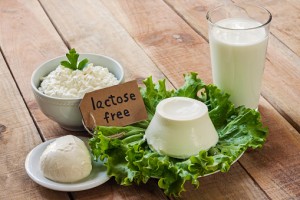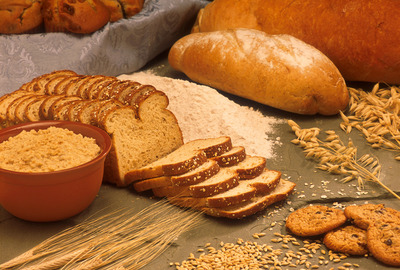Lactose intolerance and the risk of diarrhea, gas and bloating
 Lactose intolerance can increase the risk of diarrhea, gas and bloating. Lactose intolerance in the inability to digest the sugar found in milk. If the lactose cannot be digested, it can lead to complications like diarrhea, gas and bloating. Although lactose intolerance is a harmless condition, the symptoms can make it quite uncomfortable for the individual, leading to abdominal distress.
Lactose intolerance can increase the risk of diarrhea, gas and bloating. Lactose intolerance in the inability to digest the sugar found in milk. If the lactose cannot be digested, it can lead to complications like diarrhea, gas and bloating. Although lactose intolerance is a harmless condition, the symptoms can make it quite uncomfortable for the individual, leading to abdominal distress.
The enzyme lactase is produced in the small intestine and a deficiency results in lactose intolerance.
With proper management a person with a lactose intolerance can consume some dairy and avoid the side effects associated with improper digestion of milk.
Symptoms of lactose intolerance
Primary symptoms of lactose intolerance are:
- Diarrhea
- Gas
- Bloating
- Pain or cramps of the abdomen
- Gurgling or rumbling sounds
- Vomiting
Just because you may have some of these symptoms after consuming milk products, it does not necessarily mean you are lactose intolerant. Lactose intolerance is when you experience the above symptoms every time you consume milk products.
Additionally, you can go your whole life without having lactose intolerance, only to develop it late in life. It is fairly common to develop a lactose intolerance because it is dependent on the amount of lactase present in the small intestine.
It’s also important to note that lactose intolerance is not the same as a milk allergy. A person with a milk allergy cannot consume anything that contains milk, but a person with a lactose intolerance is able to consume milk products if medication to boost lactase is taken simultaneously.
Lactose intolerance not to be confused with Crohn’s disease
Lactose intolerance and Crohn’s disease are often confused with one another as they share many of the same symptoms. However, it has been shown that individuals with Crohn’s disease do have higher rates of lactose intolerance, but it is not a predictor of future lactose intolerance.
The key difference between lactose intolerance and Crohn’s disease is that in Crohn’s disease blood or mucus can be found in the stool and other distinct symptoms are present, including loss of appetite, unintentional weight loss, fever and anemia.
Foods that contain lactose
There are a wide variety of foods that contain lactose, so it’s important to recognize them in order to avoid the discomfort which follows consuming lactose. Foods containing lactose are:
- Bread and baked goods
- Pancakes, waffles, cookies and their mixes
- Processed breakfast foods
- Cereals
 Instant potatoes, soup and breakfast beverages
Instant potatoes, soup and breakfast beverages- Processed snacks (including potato chips)
- Processed meats
- Margarine
- Salad dressings
- Powdered milk and meal replacements
- Candies
- Coffee creamers
- Whipped toppings
It’s important to always read the labels of your favorite food products to ensure you are not consuming lactose, or so you can properly prepare yourself prior to consuming it.
Diagnosis and treatment of lactose intolerance
Lactose intolerance can be diagnosed based on a medical exam, history of diet, and review of symptoms. Medical tests to determine lactose intolerance are a hydrogen breath test and a stool acidity test.
In a hydrogen breath test, the amount of hydrogen in a person’s breath is measured. If a person has high levels of undigested lactose in their body, their breath will produce high amounts of hydrogen – normally this is quite low. The stool acidity test measures lactic acid and other acids in a person’s stool to determine lactose intolerance.
Although there is no cure for lactose intolerance, it can be easily treated and even allow a person to consume lactose foods. Aside from limiting the amount of lactose foods you consume, you can also try drops or pills of lactase substitutes to help your body break down the food without the discomfort that can follow.
Natural home remedies for lactose intolerance
 Because calcium is an integral part of our overall health, you will need to find other foods aside from dairy to provide it. These foods should be incorporated into the diet of a person who is lactose intolerant:
Because calcium is an integral part of our overall health, you will need to find other foods aside from dairy to provide it. These foods should be incorporated into the diet of a person who is lactose intolerant:
- Broccoli
- Calcium-rich products like breads or cereals (that don’t contain lactose)
- Canned salmon
- Soy or rice milk
- Oranges
- Pinto beans
- Rhubarb
- Spinach
Vitamin D is also important for proper absorption of calcium and eggs are quite high in vitamin D. Liver, yogurt and getting out in the sun – safely – can all provide vitamin D as well.
Constipation foods to avoid and foods to eat for relief
Food can either cause constipation or relieve constipation; the trick is knowing the right foods to eat and when. Constipation can affect anyone at any age, but it is a common problem among older adults. Constipation is the inability to pass a complete stool or have regular bowel movements. Continue reading…
-
Ab Diet – 3 Steps Guidelines for Best Results
For a flat stomach you need a good ab diet. There are some things you
-
Solar Energy: Advantages, Disadvantages And Definitions
There are many advantages and disadvantages to going solar. Before yo
-
I Lost Weight: Brad Swenson Found A Sustainable Diet Plan And Lost 200 Pounds
Got a success story of your own? Send it to us at success.stor
-
Top 20 Tips To Lose One Pound Per Week
We are two months into the New Year. Are you still trying to lose thos
-
Ways To Lose Tummy Fat - How To Do It Right
If youve been trying to shed your tummy
-
Five Weight Loss Solutions To Try
The desire and need to lose weight come in ranges. From the vain to th
- DON'T MISS
- How to Tell Others about Your Weight Loss Goals
- How To Stop Gaining Happy Pounds When Youre In Love
- Walking The Weight Off
- Weight Loss Diet Tips to Lose Weight Faster
- Weight Loss Program for the New Year
- Weight Loss Tips and Secrets That Work
- Weight Loss Tips: Want 36-24-36? Dilemma No More!
- Excess Belly Fat is Not Only Ugly, but Very Dangerous to Your Health
- Vegetarian Weight Loss
- 5 Fast And Easy Weight Loss Tips




